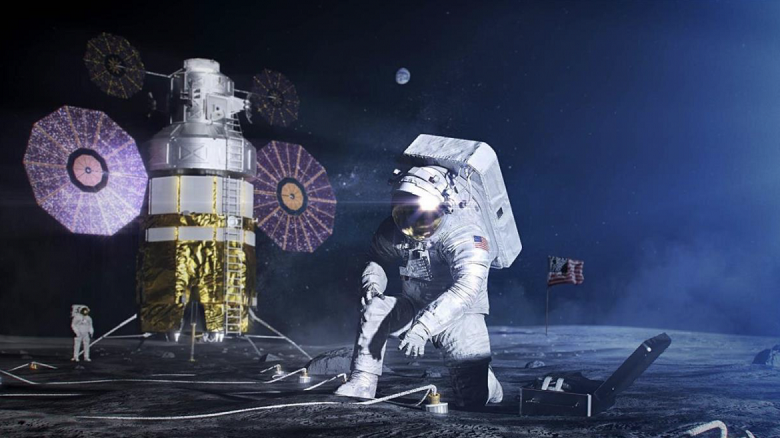Space Technology Trends: Unveiling the Future of Space Exploration

By Agnibeena Ghosh
The realm of space technology is witnessing an unprecedented surge of innovation and advancement, fuelled by the potential of exploring the final frontier. From space robotics to satellite technologies and advanced communications, key trends are shaping the future of space exploration. In this article, we delve into the cutting-edge developments that are revolutionizing the space sector.The fascination with space technology has gripped the hearts of many Indians, especially after the historic launch of Chandrayaan-3. Over the years, the space sector has witnessed a remarkable transformation, driven by a quest to enhance capabilities and push the boundaries of exploration. Leading space agencies like ISRO and NASA are at the forefront of adopting cutting-edge technologies, ranging from 3D printing to quantum computing to 5G, to propel their missions to new heights.
Beyond these advancements, emerging trends in space robotics and smart propulsion are garnering significant attention, opening up exciting possibilities for the future. As we celebrate the success of Chandrayaan-3’s third orbit-raising manoeuvre, let us take a closer look at the latest trends that are shaping the dynamic landscape of space technology.
Space Robotics: Pioneering the Future of Exploration
Space robotics has emerged as a pivotal area of interest for start-ups worldwide, driven by the prospect of these devices playing a transformative role in future space missions. Equipped with autonomous capabilities, these robots are designed to endure the hostile environment of space. According to NASA, space robots assume diverse roles, serving as caretakers for astronauts and precursors that pave the way for human exploration. Advanced robot user interfaces are being developed to facilitate collaboration, geospatial data visualization, and performance monitoring, among other functionalities.
Satellite Technologies: Igniting the Era of Smallsats
The landscape of space technology encompasses satellites, space stations, and in-space propulsion, among other varieties of technologies. A notable trend in recent times is the rise of small satellites or smallsats, which hold the potential to drive the next generation of satellite capabilities. The industry is witnessing a significant opening to private players, paving the way for innovative satellite technologies to meet the surging demand. India, in particular, has taken the lead in civilian space technology, with growing advancements in semi-cryogenic engines, reusable launch vehicles, and two-stage-to-orbit rocket launch vehicles creating new space opportunities.
Revolutionizing Communication: Enabling Seamless Connectivity
Communication is a vital aspect of space technology, facilitating real-time interactions between astronauts and mission control. Companies are diligently working on providing astronauts with seamless internet access, enhancing the efficiency of data transfer from space. The advent of 5G technology promises to revolutionize data transmission, fostering instant connectivity between space missions and Earth.
Embracing New Horizons: 3D Printing and Quantum Computing
To amplify capabilities and optimize outcomes, space agencies are embracing cutting-edge technologies like 3D printing and quantum computing. 3D printing has revolutionized the manufacturing process, enabling the creation of complex components and reducing overall costs. Quantum computing holds the potential to exponentially increase computing power, enabling faster data processing and complex simulations for space missions.
Smart Propulsion: Navigating the Cosmos Efficiently
Smart propulsion has emerged as a critical trend in space technology, with advancements aimed at optimizing spacecraft navigation and propulsion. Innovations in smart propulsion technology are focused on optimizing fuel consumption and enhancing spacecraft manoeuvrability, ensuring more cost-effective and eco-friendly space missions.
Synergies between Space Exploration and Climate Change
The space sector is increasingly recognizing the synergies between space exploration and addressing climate change. Satellites equipped with advanced sensors and instruments play a vital role in monitoring climate-related phenomena and providing crucial data for climate research. The study of Earth’s atmosphere and oceans from space contributes to a deeper understanding of climate patterns and enables the prediction of natural disasters.
The Growing Role of Private Players
The involvement of private players has ushered in a new era in space exploration, bringing innovation, efficiency, and cost-effectiveness to space missions. Collaborations between governments and private entities have spurred the development of cutting-edge technologies and accelerated space exploration endeavours.
Fostering Sustainable Space Practices
As space exploration advances, the focus on sustainable practices becomes paramount. Addressing concerns such as space debris and resource utilization is essential to ensure the long-term sustainability of space missions. Space agencies are actively exploring innovative solutions for sustainable space practices, including debris removal technologies and resource extraction from celestial bodies.
The future of space technology holds limitless possibilities, as humanity continues its journey to unravel the mysteries of the universe. Space robotics, satellite technologies, advanced communications, and innovative technologies such as 3D printing and quantum computing are revolutionizing space exploration. With private players driving innovation and global collaboration fostering breakthroughs, space exploration is poised to witness unprecedented growth and achievements. As we look to the stars, the quest for knowledge and discovery ignites our ambition to explore the unexplored and inspire future generations to reach new cosmic frontiers.






